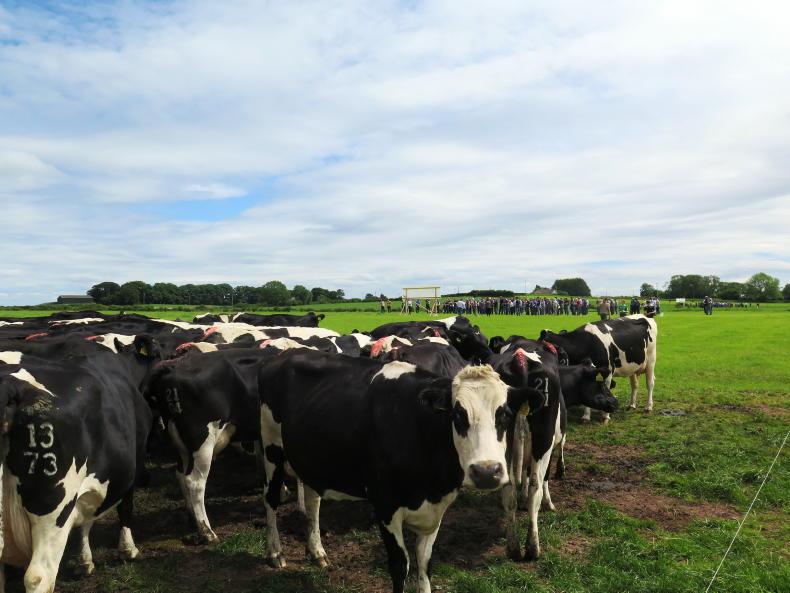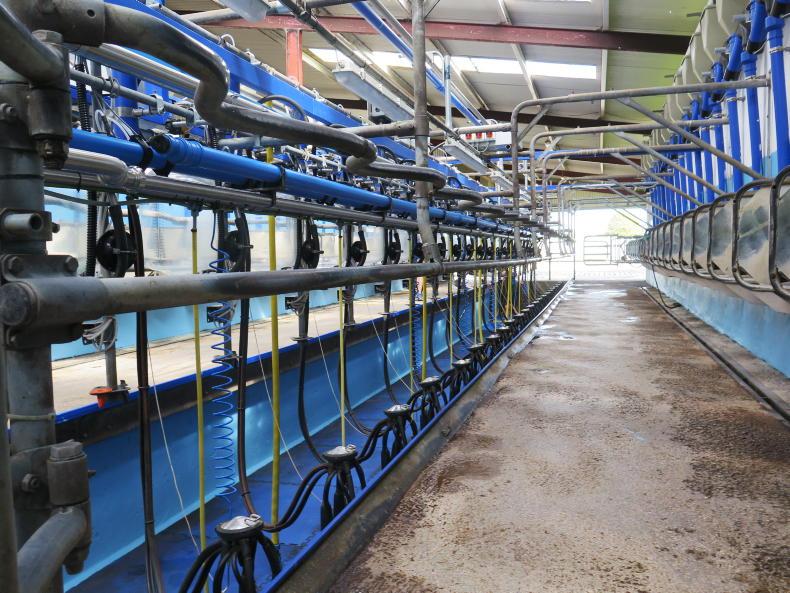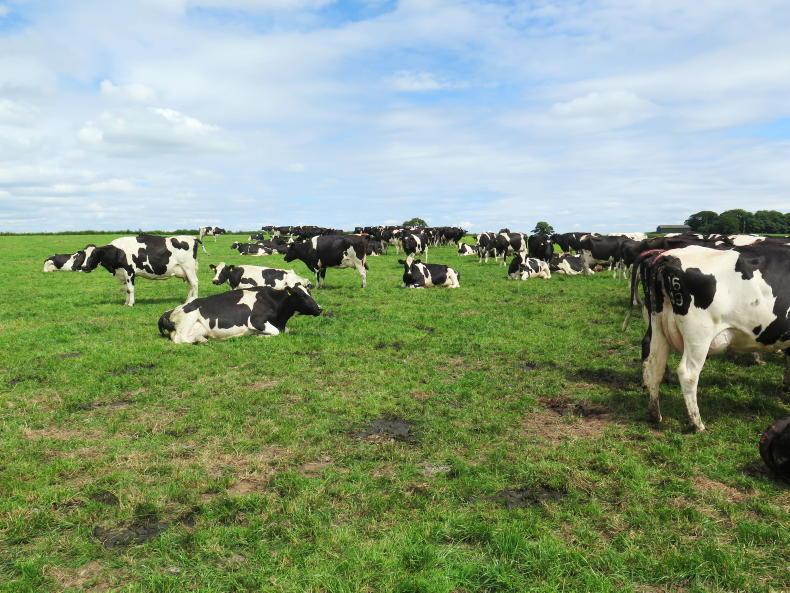Last Wednesday was the warmest day of the year so far, but rather than going to the beach for the day, farmers in Cork, Kerry, Tipperary and Limerick flocked to the McCarthy farm at Feenagh in Limerick.
What they got was better than anything a beach could offer. A herd of 170 cows doing 560kg MS/cow on 960kg of meal. A farm growing 16.5t DM/ha from 190kg N/ha and a family team all rowing in the one direction. Michael, Mary Ita and Alex McCarthy won the 2021 NDC/Kerrygold milk quality awards and hosted the open day last week.
When you strip it back, there’s nothing overly special about the farm or the people running it. Michael describes it as being a dry farm, “but not as dry as some of the limestone land in Croagh or Croom”.
The trio work hard, but so do lots of farming families. I think what makes this farm special is that good advice is taken on board and implemented properly, the simple things are done very well and they are not trying to reinvent the wheel.
Background
When Michael and Mary Ita took over the farm from Michael’s parents in 1990, they were milking 46 cows on 46ha. After school, Alex trained as a mechanic and came home to farm fulltime in 2017.
The farm has grown in size since 1990, with parcels of land purchased alongside the milking platform.

The herd is all Holstein Friesian with a six-week calving rate of 86% .
At this stage, there are 64ha of owned land in the milking platform. A further 40ha of land is leased away and is used for silage and rearing youngstock.
The overall stocking rate is 2.2 cows/ha and the stocking rate on the milking block is 2.95 cows/ha. This is set to fall, as some additional land next to the milking block was purchased this year. About 20 beef calves are kept on the farm and slaughtered at 22 months old, meaning they don’t go into the shed for the second winter. Michael says there’s not a lot of money out of keeping these beef calves, but that they end up paying for the land rent, which the replacement heifers are also grazing.
In terms of milk quality, the stats for last year are 4.20% butterfat, 3.59% protein, TBC of 4,000 and SCC of 108,000, with thermoduric averaging 127,000.
Herd
The cows are all Holstein Friesian, with an average EBI of €176, €59 for milk sub-index and €70 for fertility sub-index. The herd is high-yielding with 559kg MS/cow produced last year and 531kg MS/cow produced the year before. Michael says the breeding focus has shifted a bit in recent years, with a much greater emphasis now on maintenance and health traits.
“Good milk and fertility figures in bulls are nearly a given now, so most of the time when we’re picking bulls, we’re looking at health and maintenance because there’s a bigger variation between bulls.”

Simple air ram-operated drafting gate.
The McCarthys are looking for bulls with a maintenance figure of around €10, because they don’t want the cows to get too big. This year’s heifer calves have an EBI of €235 with a PD for fat of 0.16% and a PD for protein of 0.12%, which is a good bit higher than the herd PD of fat and protein at 0.05% and 0.07% respectively. The six-week calving rate in 2022 was 86% and it took 20 days for half the cows to calve.
“We’re also more selective now on what cows we breed replacements from. Any cow less than 3.6% protein gets a beef straw. We have a bit more tolerance for a first-calver, as she’s still developing. There are times you’d be questioning yourself, putting a beef straw into what you might think is a good cow, but it’s the right thing to do,” he says.
There were 44 straws of sexed semen used in 2021, with 22 of these used on heifers with a very poor conception rate. Despite this, they haven’t given up on sexed semen and used 72 straws this year, with 14 used on heifers. So far, nine of these seem to have held, which is a 64% non-return rate. Insemination to normal heats was used this year, with the heifers kept in the field next to the kitchen window to help with heat detection.
Carbon
One of the most impressive figures displayed on the day was the carbon footprint figure. At the most recent Bord Bia audit in 2021, this was 0.7kg CO2/kg milk ,which is 30% less than the national average. At the previous audit in 2019, the carbon footprint was 0.87kg CO2/kg milk ,so there was a 21% reduction during that period.
Improved grassland management has been one of the catalysts for the reduction in carbon footprint. Since Alex came home, he has taken over grass management. He recorded 48 grass covers in 2020 and 46 covers in 2021. Cows go to grass in late January and typically get over 300 days at grass every year.

The milking parlour was upgraded to a 22 unit last winter.
Soil fertility has been improving but even still, only one-third of the farm is optimum for soil pH, phosphorus and potassium. However, this includes the outfarms also, which tend to have lower soil fertility. Alex says that at this stage, almost all the milking platform is at target soil fertility, with potash being the most challenging nutrient to bring up.
The improvements in soil fertility have enabled the McCarthys to do two things – reduce the amount of chemical N being applied while maintaining yield, because what N is applied is used more efficiently, and, secondly, incorporate clover to fix nitrogen.
At this stage, 30% of the milking platform has received decent levels of clover, enabling Alex to reduce the amount of nitrogen being spread. The good clover fields are getting 12 units N/ac, while the fields with little or no clover are getting 16 units N/ac after each grazing.
Some multispecies swards were sown this year, alongside a grass and clover reseed to see how it goes. The paddocks that were oversown with clover last year have gotten a good take and are on the low-N regime this year.
In terms of labour, all three work together on the farm, with Alex’s younger brother James helping out in the busy times too. Contractors are used for silage, reseeding, hedge-cutting and most of the slurry work.

The McCarthy herd of 170 cows has an EBI of €176.
Facilities on the farm are top class, with a new silage pit complex built in 2018 and a ring added to the slurry tower in 2020, giving 20% more slurry storage than required. The parlour was upgraded from a 16-unit to a 22-unit De Laval last winter.
Over 80% of the cows got selective dry cow therapy last year, with any cow with an SCC of less than 175 nominated for sealer only. Cubicles are limed daily with a Bobman and there is one cubicle space per cow, with ample feed space.
“We dry off no more than one row at a time and all three of us are involved in the process. I clean and disinfect the teats, Mary Ita hands Alex the tubes and he inserts them.
“It means Alex is never coming in contact with a dirty teat, so it helps to prevent the risk of introducing infection. We find that the cows that need antibiotics at drying off usually have a baggy udder or some other health problem such as lameness. That’s why we feel the EBI for health is so important,” Michael says.
McCarthy family are milking 170 cows on a 64ha milking platform at Feenagh in Co Limerick.They won the NDC/Kerrygold milk quality awards in 2021 for excellent milk quality.The herd produced 559kg MS/cow in 2021 from 960kg of meal and a carbon footprint of 0.7kg CO2/kg milk.By the end of the year, almost 40% of the farm will have good clover established.
Last Wednesday was the warmest day of the year so far, but rather than going to the beach for the day, farmers in Cork, Kerry, Tipperary and Limerick flocked to the McCarthy farm at Feenagh in Limerick.
What they got was better than anything a beach could offer. A herd of 170 cows doing 560kg MS/cow on 960kg of meal. A farm growing 16.5t DM/ha from 190kg N/ha and a family team all rowing in the one direction. Michael, Mary Ita and Alex McCarthy won the 2021 NDC/Kerrygold milk quality awards and hosted the open day last week.
When you strip it back, there’s nothing overly special about the farm or the people running it. Michael describes it as being a dry farm, “but not as dry as some of the limestone land in Croagh or Croom”.
The trio work hard, but so do lots of farming families. I think what makes this farm special is that good advice is taken on board and implemented properly, the simple things are done very well and they are not trying to reinvent the wheel.
Background
When Michael and Mary Ita took over the farm from Michael’s parents in 1990, they were milking 46 cows on 46ha. After school, Alex trained as a mechanic and came home to farm fulltime in 2017.
The farm has grown in size since 1990, with parcels of land purchased alongside the milking platform.

The herd is all Holstein Friesian with a six-week calving rate of 86% .
At this stage, there are 64ha of owned land in the milking platform. A further 40ha of land is leased away and is used for silage and rearing youngstock.
The overall stocking rate is 2.2 cows/ha and the stocking rate on the milking block is 2.95 cows/ha. This is set to fall, as some additional land next to the milking block was purchased this year. About 20 beef calves are kept on the farm and slaughtered at 22 months old, meaning they don’t go into the shed for the second winter. Michael says there’s not a lot of money out of keeping these beef calves, but that they end up paying for the land rent, which the replacement heifers are also grazing.
In terms of milk quality, the stats for last year are 4.20% butterfat, 3.59% protein, TBC of 4,000 and SCC of 108,000, with thermoduric averaging 127,000.
Herd
The cows are all Holstein Friesian, with an average EBI of €176, €59 for milk sub-index and €70 for fertility sub-index. The herd is high-yielding with 559kg MS/cow produced last year and 531kg MS/cow produced the year before. Michael says the breeding focus has shifted a bit in recent years, with a much greater emphasis now on maintenance and health traits.
“Good milk and fertility figures in bulls are nearly a given now, so most of the time when we’re picking bulls, we’re looking at health and maintenance because there’s a bigger variation between bulls.”

Simple air ram-operated drafting gate.
The McCarthys are looking for bulls with a maintenance figure of around €10, because they don’t want the cows to get too big. This year’s heifer calves have an EBI of €235 with a PD for fat of 0.16% and a PD for protein of 0.12%, which is a good bit higher than the herd PD of fat and protein at 0.05% and 0.07% respectively. The six-week calving rate in 2022 was 86% and it took 20 days for half the cows to calve.
“We’re also more selective now on what cows we breed replacements from. Any cow less than 3.6% protein gets a beef straw. We have a bit more tolerance for a first-calver, as she’s still developing. There are times you’d be questioning yourself, putting a beef straw into what you might think is a good cow, but it’s the right thing to do,” he says.
There were 44 straws of sexed semen used in 2021, with 22 of these used on heifers with a very poor conception rate. Despite this, they haven’t given up on sexed semen and used 72 straws this year, with 14 used on heifers. So far, nine of these seem to have held, which is a 64% non-return rate. Insemination to normal heats was used this year, with the heifers kept in the field next to the kitchen window to help with heat detection.
Carbon
One of the most impressive figures displayed on the day was the carbon footprint figure. At the most recent Bord Bia audit in 2021, this was 0.7kg CO2/kg milk ,which is 30% less than the national average. At the previous audit in 2019, the carbon footprint was 0.87kg CO2/kg milk ,so there was a 21% reduction during that period.
Improved grassland management has been one of the catalysts for the reduction in carbon footprint. Since Alex came home, he has taken over grass management. He recorded 48 grass covers in 2020 and 46 covers in 2021. Cows go to grass in late January and typically get over 300 days at grass every year.

The milking parlour was upgraded to a 22 unit last winter.
Soil fertility has been improving but even still, only one-third of the farm is optimum for soil pH, phosphorus and potassium. However, this includes the outfarms also, which tend to have lower soil fertility. Alex says that at this stage, almost all the milking platform is at target soil fertility, with potash being the most challenging nutrient to bring up.
The improvements in soil fertility have enabled the McCarthys to do two things – reduce the amount of chemical N being applied while maintaining yield, because what N is applied is used more efficiently, and, secondly, incorporate clover to fix nitrogen.
At this stage, 30% of the milking platform has received decent levels of clover, enabling Alex to reduce the amount of nitrogen being spread. The good clover fields are getting 12 units N/ac, while the fields with little or no clover are getting 16 units N/ac after each grazing.
Some multispecies swards were sown this year, alongside a grass and clover reseed to see how it goes. The paddocks that were oversown with clover last year have gotten a good take and are on the low-N regime this year.
In terms of labour, all three work together on the farm, with Alex’s younger brother James helping out in the busy times too. Contractors are used for silage, reseeding, hedge-cutting and most of the slurry work.

The McCarthy herd of 170 cows has an EBI of €176.
Facilities on the farm are top class, with a new silage pit complex built in 2018 and a ring added to the slurry tower in 2020, giving 20% more slurry storage than required. The parlour was upgraded from a 16-unit to a 22-unit De Laval last winter.
Over 80% of the cows got selective dry cow therapy last year, with any cow with an SCC of less than 175 nominated for sealer only. Cubicles are limed daily with a Bobman and there is one cubicle space per cow, with ample feed space.
“We dry off no more than one row at a time and all three of us are involved in the process. I clean and disinfect the teats, Mary Ita hands Alex the tubes and he inserts them.
“It means Alex is never coming in contact with a dirty teat, so it helps to prevent the risk of introducing infection. We find that the cows that need antibiotics at drying off usually have a baggy udder or some other health problem such as lameness. That’s why we feel the EBI for health is so important,” Michael says.
McCarthy family are milking 170 cows on a 64ha milking platform at Feenagh in Co Limerick.They won the NDC/Kerrygold milk quality awards in 2021 for excellent milk quality.The herd produced 559kg MS/cow in 2021 from 960kg of meal and a carbon footprint of 0.7kg CO2/kg milk.By the end of the year, almost 40% of the farm will have good clover established. 









 This is a subscriber-only article
This is a subscriber-only article










SHARING OPTIONS: